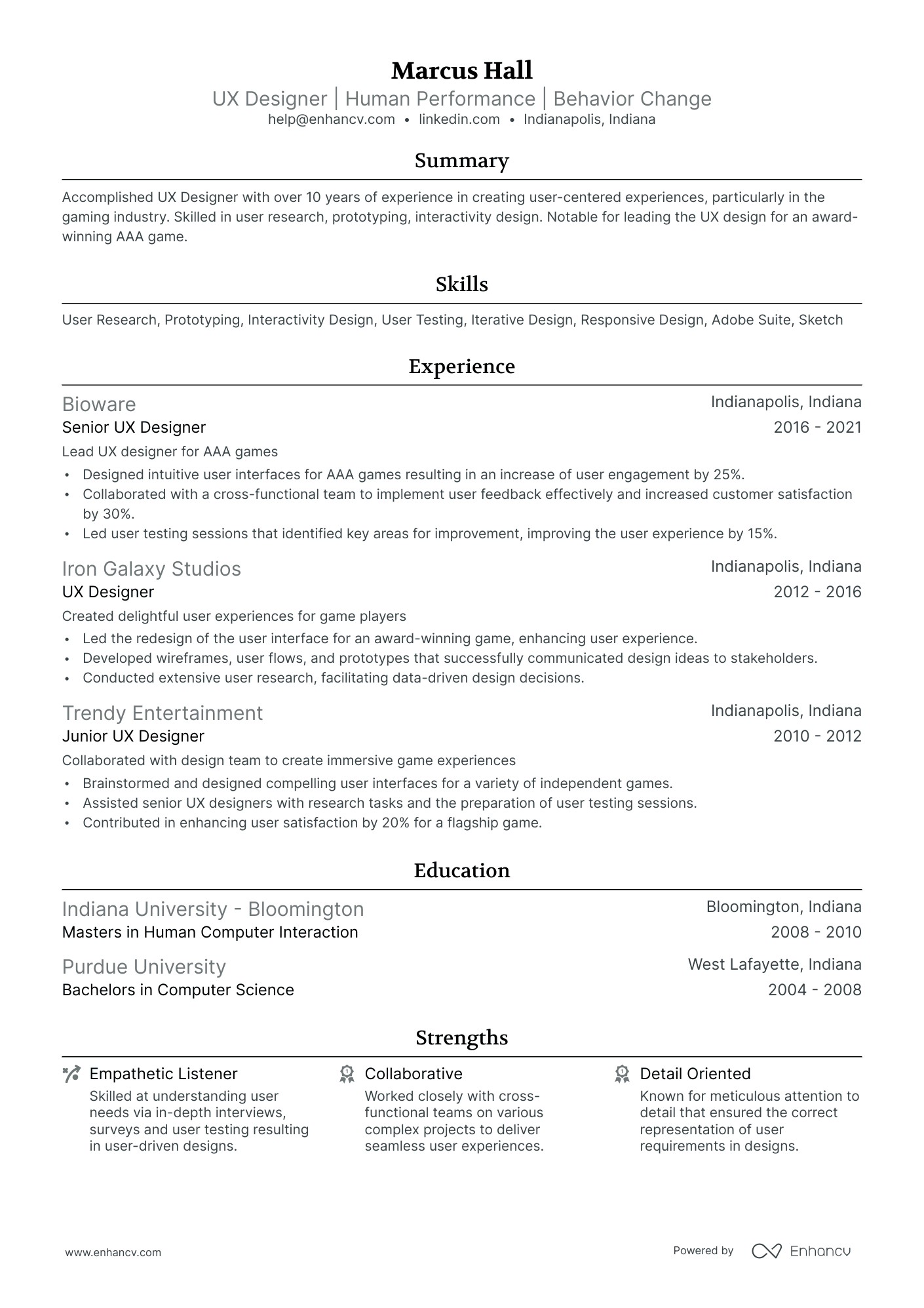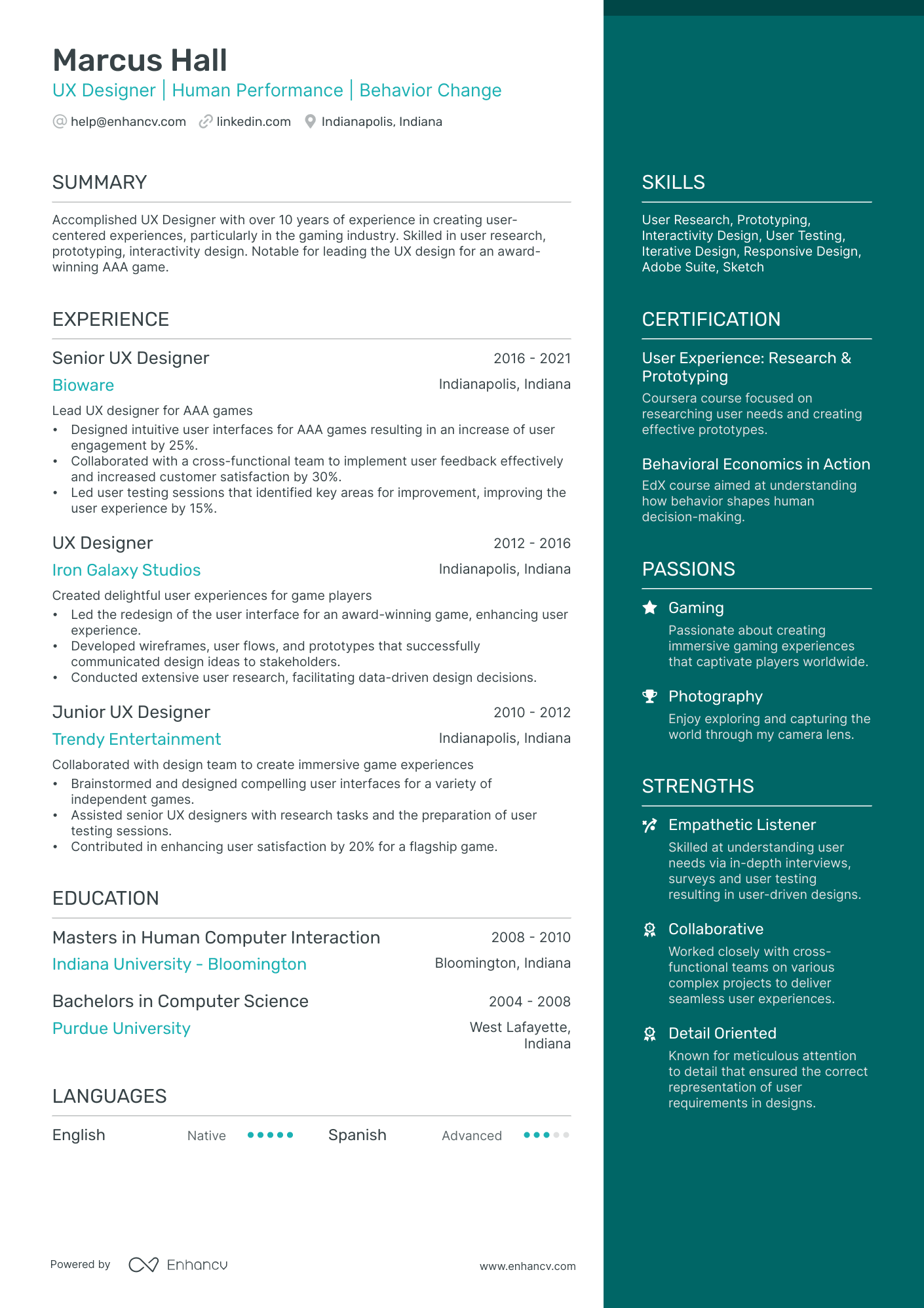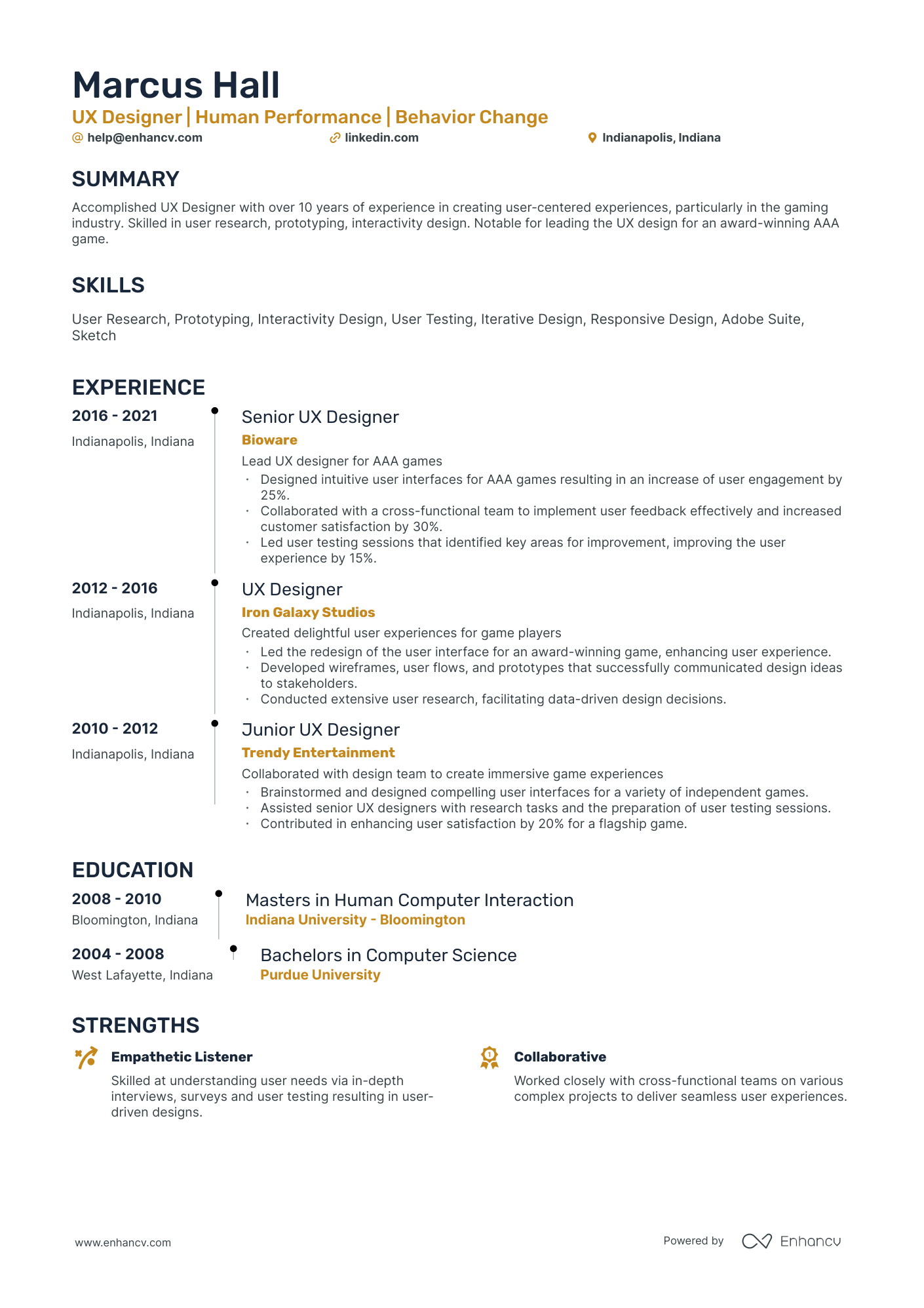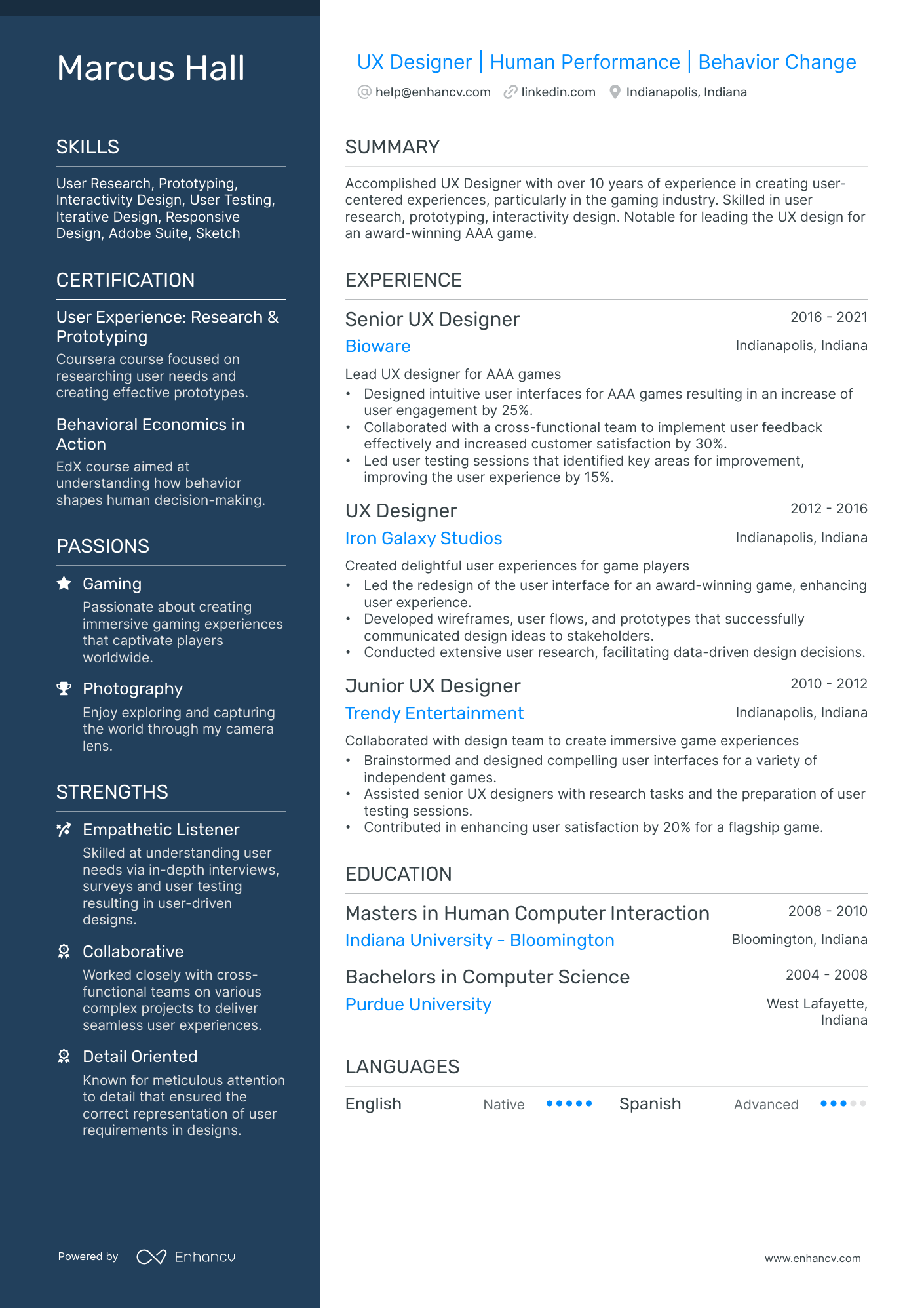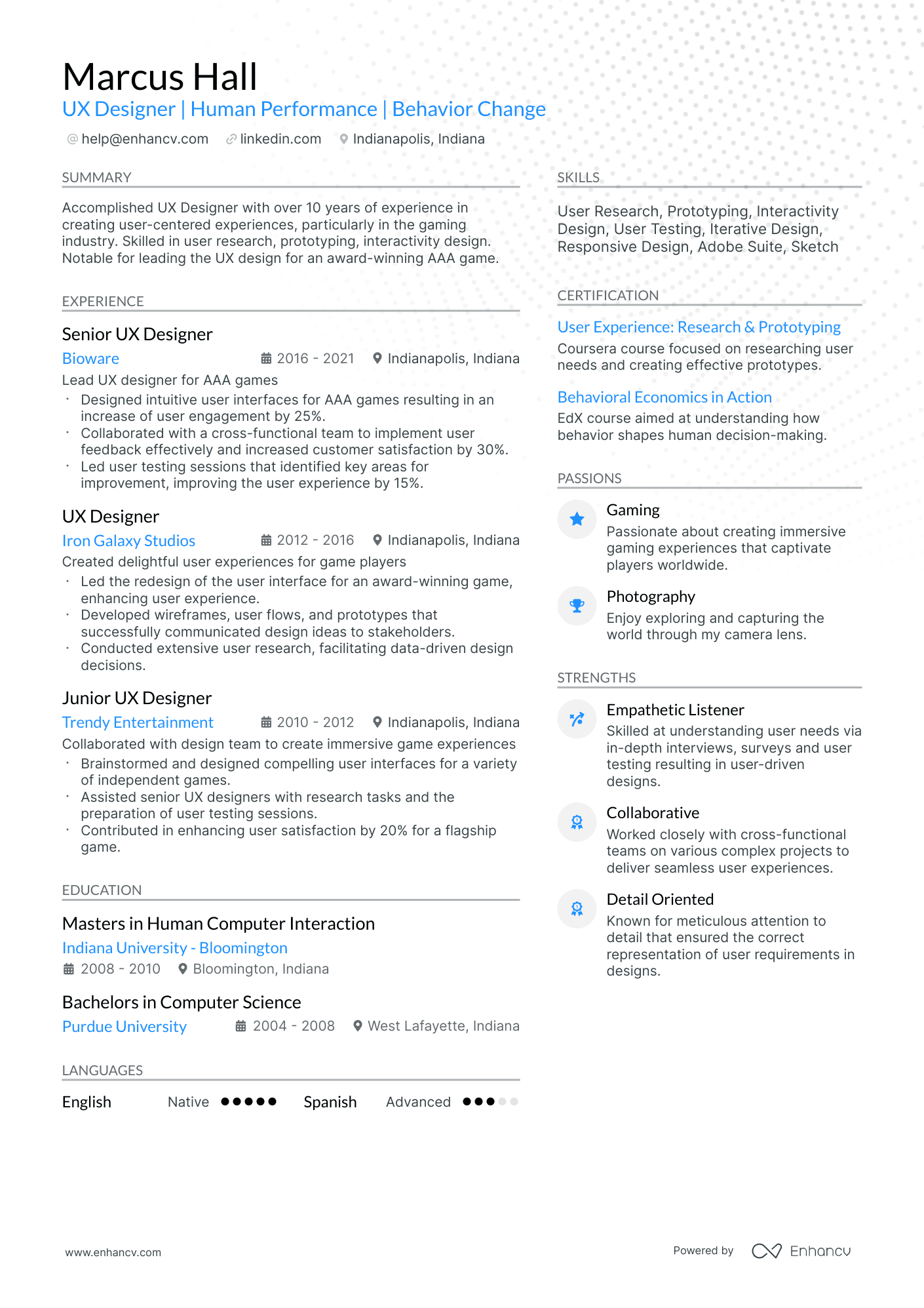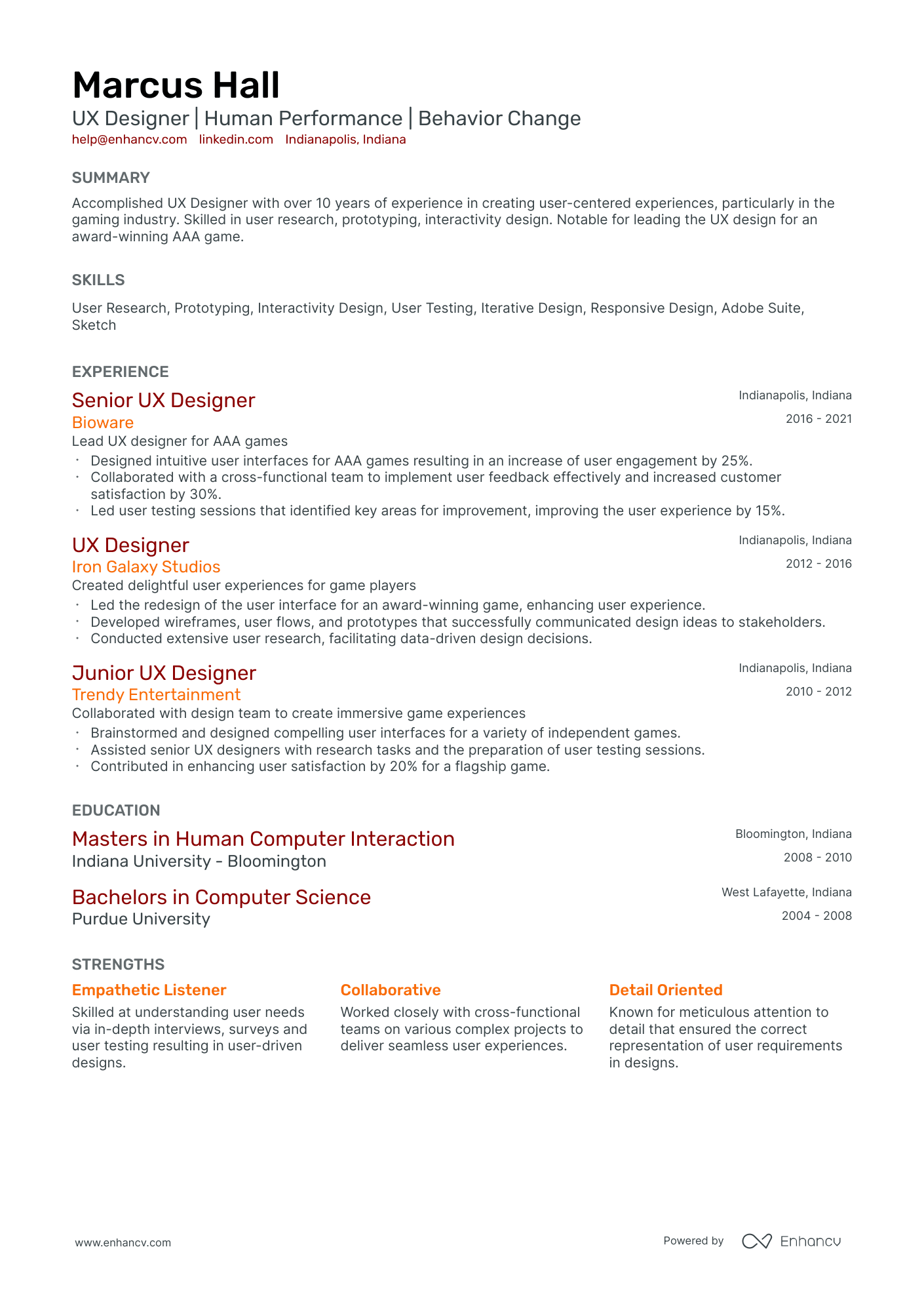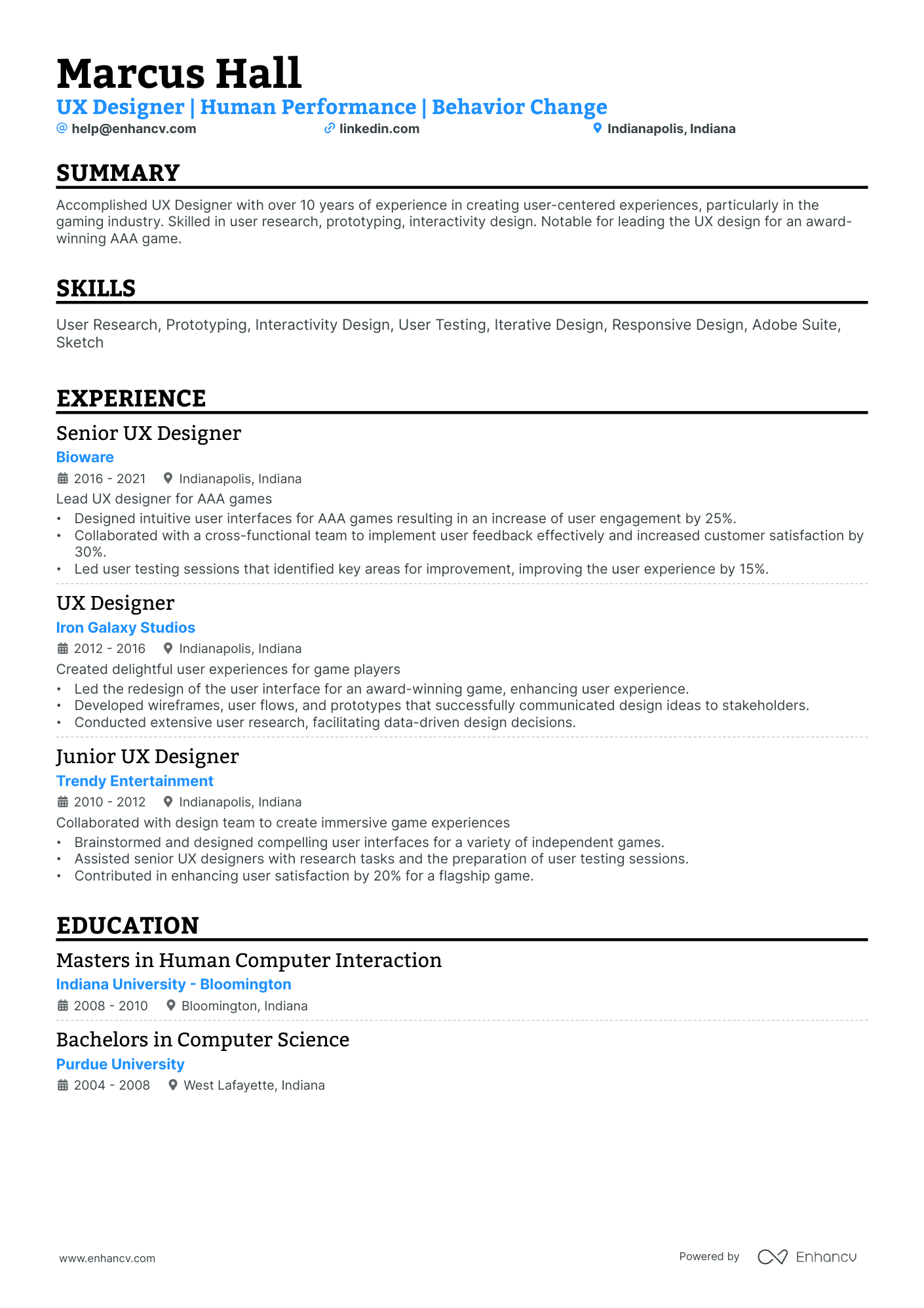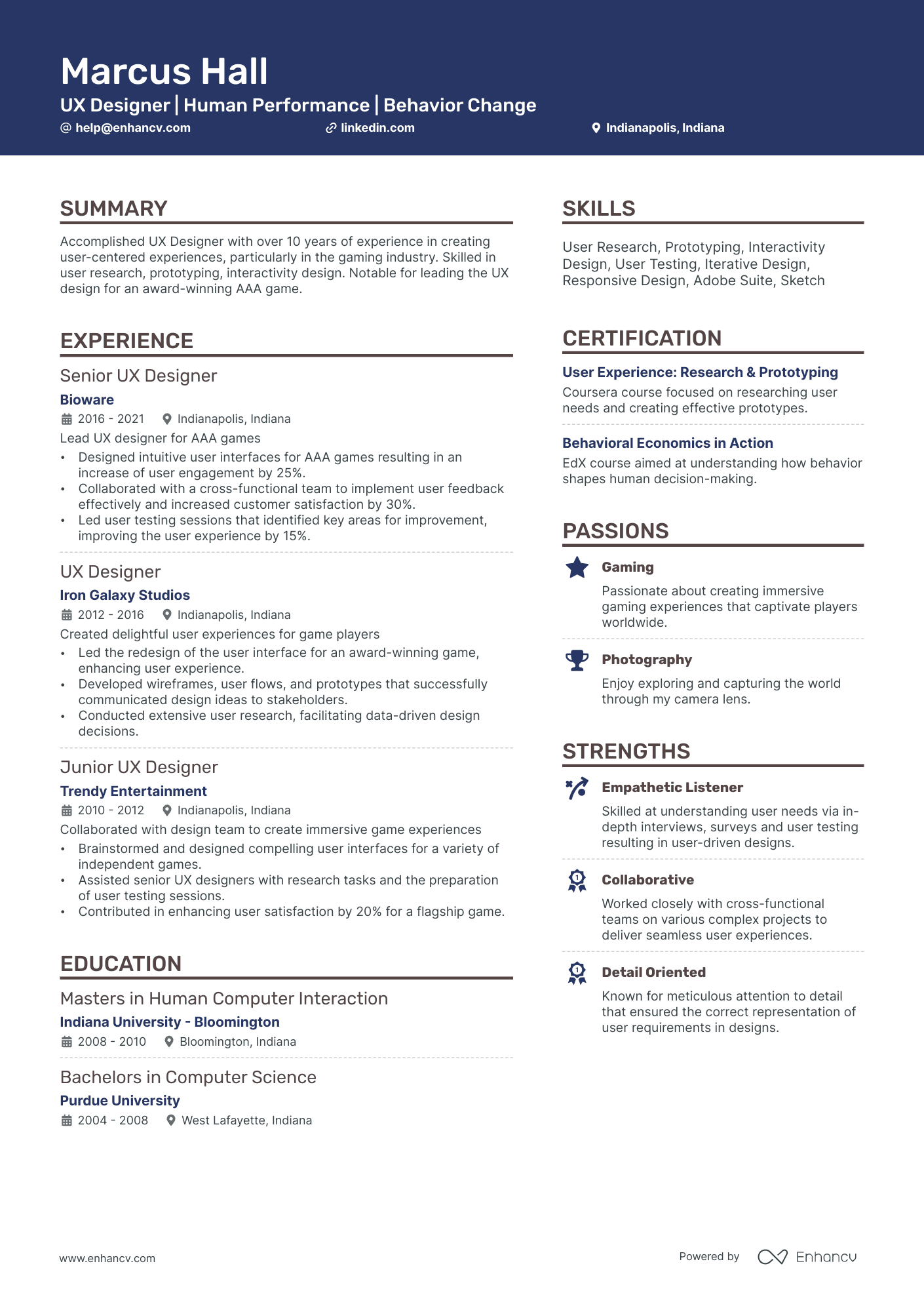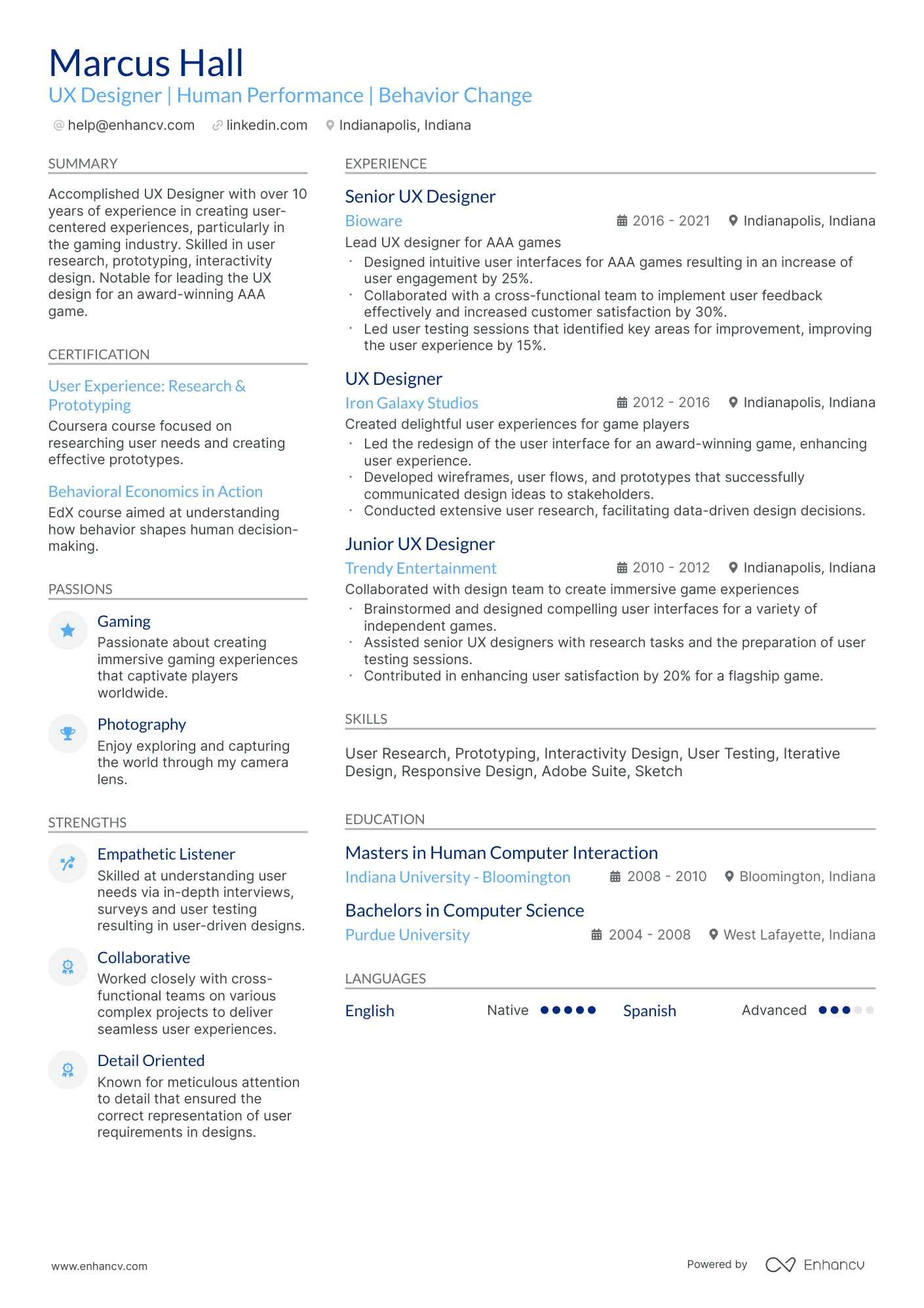One primary challenge for a senior UX designer is effectively showcasing their complex portfolio of skills and experiences in a succinct way on a resume. Our guide can assist by providing tailored strategies to help you articulate and organize your diverse competencies, projects, and achievements in a concise, compelling manner.
Dive into this guide to learn how to craft a senior UX designer resume that offers recruiters a clear view of your career journey:
- Draw from our senior UX designer resume samples, highlighting top skills, certifications, and more.
- Illuminate the potential impact you can bring to an organization through your resume summary and experience.
- Spotlight your unique senior UX designer expertise, emphasizing tangible results and standout achievements.
Recommended reads:
Demystifying the senior UX designer resume format
While a touch of creativity can be appealing, it's the clarity and relevance of your senior UX designer resume format that truly resonates with recruiters.
To ensure your resume not only captures attention but also maintains it, consider these four streamlined steps:
- If your career boasts a wealth of pertinent and recent accomplishments, the reverse-chronological resume format is your ally. It naturally emphasizes your experience, placing your most recent roles at the forefront.
- Design a straightforward header: incorporate your contact information, a headline reflecting the position you're vying for or your current designation, and a link to your professional portfolio.
- While brevity is key, if you're targeting a senior position or have accumulated over ten years of industry-relevant experience, extending your resume to two pages is permissible.
- To ensure consistent formatting across various platforms, always save and submit your senior UX designer resume as a PDF.
Consider your target market – resumes in Canada, for example, follow different layout conventions.
Upload your resume
Drop your resume here or choose a file. PDF & DOCX only. Max 2MB file size.
Pro tip
Consider incorporating design elements like icons or charts to enhance your resume's visual appeal and readability. But remember, the key is subtlety; don't let design overshadow content.
Recruiters' top picks for senior UX designer resume sections:
- A header with essential contact details and a headline showcasing your current role.
- A summary or objective that aligns your standout expertise with the role's demands.
- An experience section that delves into your key responsibilities and achievements.
- A skills section that intertwines job requirements with your unique capabilities.
- Education and certifications sections that bolster your professional credentials.
What recruiters want to see on your resume:
- Experience with various UX design tools like Sketch, Figma, Adobe XD, etc.
- Demonstrated understanding of user-centered design principles and best practices
- Evidence of practical skills through a diverse portfolio showcasing end-to-end projects
- Proficiency in user research methodologies and usability testing
- Strong collaboration and communication abilities, especially working with cross-functional teams
Recommended reads:
Optimizing your senior UX designer resume experience section
Your resume's experience section should resonate with your accomplishments while aligning with the job's demands. Here's how:
- Highlight significant career moments, and back them up with relevant skills.
- Analyze the job description to address both basic and advanced requirements.
- If you have unrelated roles, consider a separate section, but emphasize transferable skills.
- Avoid listing roles from over a decade ago unless they showcase your trajectory, especially for senior roles.
- Illustrate how your contributions enhanced the team or company, linking challenges to solutions.
Review how seasoned senior UX designer professionals have crafted their experience sections, emphasizing their contributions.
- Led user research initiatives, conducting interviews and usability testing, resulting in a 20% increase in user satisfaction.
- Collaborated with cross-functional teams to create intuitive user interfaces, improving conversion rates by 15%.
- Developed wireframes and prototypes using industry-standard tools, facilitating efficient communication between design and development teams.
- Implemented data-driven design decisions based on user analytics, reducing bounce rate by 10%.
- Created and maintained design systems to ensure consistency across multiple product lines.
- Conducted user interviews and contextual inquiries to inform the design process, resulting in a 30% decrease in user errors.
- Collaborated closely with product managers and engineers to define feature requirements and prioritize design enhancements.
- Designed and prototyped mobile applications, optimizing user flows and achieving a 25% increase in app engagement.
- Led a redesign project for a flagship product, resulting in a 40% improvement in overall user satisfaction.
- Conducted A/B tests and analyzed user feedback to iterate and optimize user experiences.
- Researched and identified user needs through usability testing and ethnographic research, leading to a 15% boost in customer retention.
- Collaborated with visual designers and front-end developers to create visually appealing and user-friendly interfaces.
- Developed and maintained a comprehensive style guide to ensure consistent branding and design language across products.
- Conducted competitor analysis to identify market trends and inform UX strategy.
- Facilitated design workshops and presented design concepts to stakeholders.
- Designed and optimized user interfaces for web applications, resulting in a 20% increase in user engagement.
- Collaborated with cross-functional teams to define user personas and user flows for new product features.
- Created interactive prototypes to validate design concepts and gather user feedback for iterative improvements.
- Conducted heuristic evaluations and usability audits to identify areas for UX enhancements.
- Participated in agile development processes, providing UX expertise and ensuring timely delivery of design assets.
- Assisted in user research activities, including user interviews and usability testing sessions.
- Contributed to the creation of wireframes and low-fidelity prototypes to communicate design concepts.
- Conducted competitive analysis to identify strengths and weaknesses of rival products.
- Supported the design team in creating user-centered solutions by gathering and organizing user feedback.
- Collaborated with developers to ensure accurate implementation of design specifications.
- Led user research efforts, including conducting user interviews and usability tests with diverse user groups.
- Collaborated closely with product managers to define UX goals and translate them into actionable design solutions.
- Designed intuitive user interfaces for complex enterprise software, resulting in a 25% increase in user productivity.
- Created interactive prototypes using cutting-edge prototyping tools for user validation and stakeholder presentations.
- Implemented accessibility best practices to ensure compliance with WCAG 2.1 guidelines.
- Conducted user research studies, including surveys and usability testing, to gain insights into user behavior and needs.
- Collaborated with visual designers to create visually appealing interfaces that aligned with brand guidelines.
- Redesigned the onboarding experience resulting in a 20% decrease in user drop-off rates.
- Facilitated workshops and design sprints to ideate and validate new product features.
- Provided mentorship and guidance to junior members of the UX team.
- Conducted user interviews and usability tests to gather insights and validate design decisions.
- Collaborated with cross-functional teams to define user personas and develop user flows.
- Designed responsive web interfaces, ensuring seamless experiences across different devices.
- Worked closely with front-end developers to implement designs and provide guidance on UX best practices.
- Contributed to the development of a design system, improving consistency and efficiency in the design process.
- Conducted user research activities, including usability testing and interviews, to inform design decisions.
- Collaborated with product managers and engineers to define user requirements and prioritize features.
- Created wireframes and interactive prototypes to communicate design concepts and gather feedback.
- Iteratively improved user experiences based on user feedback and data analysis.
- Assisted in the creation and maintenance of a design system for consistent visual language and interaction patterns.
- Assisted in conducting user research studies, including usability tests and surveys.
- Contributed to the creation of wireframes and mockups to visualize design concepts.
- Performed heuristic evaluations to identify usability issues and propose improvements.
- Collaborated with developers to ensure accurate implementation of design specifications.
- Participated in design reviews and provided constructive feedback to improve overall product experience.
Quantifying impact on your resume
<ul>
Navigating the resume landscape without experience
It's not uncommon for candidates lacking direct experience to secure entry-level positions. Their resumes often share these characteristics:
- They opt for a functional or skill-based format, emphasizing strengths over chronological work history.
- Transferrable skills, gleaned from diverse life and work experiences, take center stage.
- The objective section melds career highlights, the motivation behind the application, and the unique value proposition for the role.
- Skills are tailored to meet basic job prerequisites while also spotlighting any specialized expertise.
Recommended reads:
Pro tip
Remember, the experience section isn't just about traditional roles. It's a space to highlight all professional learning, whether from internships, contract roles, research projects, or other relevant experiences. If it's added value to your skill set for the senior UX designer role, it deserves a mention.
Decoding the essence of your senior UX designer resume: hard and soft skills
Every job description communicates the desired hard and soft skills. These skills are the backbone of your application.
Hard skills are your tangible, technical proficiencies, often validated through certifications or hands-on experience. On the other hand, soft skills reflect your interpersonal abilities and how you navigate diverse work environments.
To effectively spotlight these skills on your resume:
- Create a distinct section for technical skills, listing the most relevant ones for the job.
- Highlight your strengths by weaving in achievements that underscore specific skills.
- Strike a balance between hard and soft skills to present a well-rounded profile.
- If multilingual, include a language proficiency section, emphasizing the interpersonal advantages it brings.
Stay tuned for a deep dive into the most in-demand hard and soft skills in the industry.
Top skills for your senior UX designer resume:
Figma
Sketch
Adobe XD
InVision
HTML/CSS
JavaScript
User Research
Wireframing
Prototyping
Usability Testing
Communication
Collaboration
Problem-solving
Critical Thinking
Empathy
Time Management
Adaptability
Creativity
Attention to Detail
Leadership
Pro tip
If the job emphasizes team or organizational culture, dedicate a section of your resume to underscore your strengths and achievements. Top-tier senior UX designer candidates also highlight their alignment with a company's values and culture.
Optimizing the education and certification sections of your senior UX designer resume
Your education and certification sections can be game-changers on your senior UX designer resume, showcasing your commitment to professional growth.
For the education section:
- Highlight advanced education, noting the institution and duration.
- If you're currently studying, mention your expected graduation date.
- Exclude degrees that don't align with the job's requirements.
- If relevant, delve into your academic journey, spotlighting significant achievements.
When listing degrees and certifications:
- Feature those directly relevant to the role.
- Highlight recent and significant knowledge or certifications at the top of your resume.
- Provide essential details like the issuing institution and dates for credibility.
- Avoid listing irrelevant degrees or certifications, such as your high school diploma or unrelated specializations.
Remember, even if you're tempted to omit your education or certifications, they can offer a competitive edge, signaling a long-term commitment to the industry.
Best certifications to list on your resume
Pro tip
The reputation of the institution or organization granting your certification or degree can bolster your credibility. Prioritize recognized and respected credentials.
Recommended reads:
Adding a summary or objective to your senior UX designer resume
One of the most crucial elements of your professional presentation is your resume's top one-third.
This most often includes:
- Either a resume summary - your career highlights at a glance. Select the summary if you have plenty of relevant experience (and achievements), you'd like recruiters to remember about your application.
- Or, a resume objective - to showcase your determination for growth. The perfect choice for candidates with less experience, who are looking to grow their career in the field.
If you want to go above and beyond with your senior UX designer resume summary or resume objective, make sure to answer precisely why recruiters need to hire you.
What is the additional value you'd provide to the company or organization?
Now here are examples from real-life senior UX designer professionals, whose resumes have helped them land their dream jobs:
Resume summary and objective examples for a senior UX designer resume
Optimize your resume summary and objective for ATS
Drop your resume here or choose a file.
PDF & DOCX only. Max 2MB file size.
How to include other relevant sections for your senior UX designer resume
Apart from the standard sections listed in this guide, you have the opportunity to get creative when building your profile.
Select additional resume sections that you deem align with the role, the department, or the company culture.
Here are the ones we recommend:
- Language skills - use a profficiency framework to indicate your aptitude level;
- Hobbies and interests - you can share more about your favorite books or how you spend your time. It's great for culture alignment;
- Volunteering - helps you highlight the causes you care about and hints at people skills you gained such as teamwork, emotional intelligence, and organizational skills;
- Awards - the space for your most prominent senior UX designer professional accolades and achievements.
Make sure that these sections don't take too much away from your experience, but instead build up your senior UX designer professional profile. You can add them as a second column to your resume, or on a second page.
Key takeaways
- Your resume's layout should be both visually appealing and content-rich.
- Emphasize achievements that resonate with the job's requirements.
- Detail your skills, both technical and interpersonal, with real-world examples.
- Ensure the top section of your resume provides a clear snapshot of who you are and what you offer.
- When detailing experience, focus on tasks, actions, and their outcomes.
